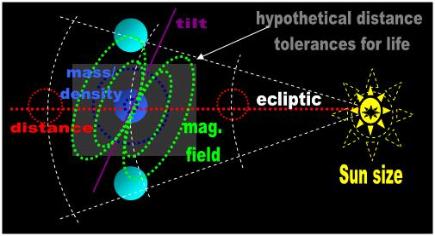| Adapted for the Internet from: Why God Doesn't Exist |
- 1.0 Statistically, we can't be the only life in the Universe
The astronomer Harlow Shapley estimated that if one out of a trillion planets meets the tests for life, in an observable universe
with 100 million trillion stars there should be some 100 million planets teeming with intelligent life. [1] Most astronomers will
probably agree with him. The experts extrapolate these conclusions from the elevated number of Sun-like stars that they
observe in our galaxy:
- “ the Milky Way, is 100,000 light years across and contains approximately a hundred
billion stars… About 10% of the stars in the Milky Way galaxy are Sun-like, and there
are about a thousand such stars within 100 light-years of the Sun.” [2]
The insinuation is that, from a statistical perspective, it is next to impossible that ours is the only planet in the Universe that
has developed intelligence, let alone life. Spectral analysis has confirmed that the most important elements of life a we know
it – carbon, hydrogen, oxygen, and nitrogen – are found in most stars. These statistics give organizations such as the Search
for Extraterrestrial Intelligence (SETI) confidence to spend your tax dollars in an effort to talk with someone other than an
earthling over the phone.
- [Lately, SETI relies more on private donations. Government funds dried up because SETI
failed to produce tangible results. However, taxes sometimes have a stealthy way of
reaching organizations such as SETI through contracts. Nevertheless, if government
money is not being diverted to SETI at this moment, this doesn't mean that it won't flow
in the future as it did in the past. Therefore, it is worthwhile to determine whether SETI
has any reason to exist in the first place.]
2.0 But statistically, we are the only life in the Solar System or that we know of!
However, probability can also be used to play devil’s advocate:
- • The lifebelt is constrained to an insignificant 0.00004 % of cross-sectional area of the Solar
- System.
- • The mass of our planet including the life upon it is only about 0.000003 % of the total mass
- of the Solar System. Watson [3] estimates that life comprises only about 0.0000001 % of the
mass of the Earth.
These numbers objectively show what a scarce resource life really is in our own neighborhood! If we now consider that the
Sun was burning for millions of years before life arose on Earth and will probably continue exhausting its fuel after life has
ceased, we have to place these numbers in an even bleaker context. While inanimate matter is eternal, life only has a minute
to make its case in court. Hence, left to statistics, it could just as well be argued that it is overly optimistic to expect e-mails
from outer space within our lifetimes.
3.0 Life demands tight specifications
In fact, when we look at the tolerances known to be necessary for life, we end up with a very disheartening picture about the
possibility of life existing elsewhere. You should conclude that it is statistically more improbable to discover a system teaming
with life within the next million years. By merely considering the hundreds of celestial bodies drifting mindlessly throughout
the Solar System, life does not seem to be a very popular phenomenon. As a minimum, life requires an atmosphere, and only
massive objects such as planets and moons may generate the necessary gravity to hold one. Gravity, in turn is a function of
mass, but then both gravity and mass are like the story of Goldilocks: the planet can't be too big and it can't be too small. It
has to be just right.
Life also has an absolute respect for the God of Temperature. And temperature essentially comes down to how far a planet is
from the Sun! Just to get a feel for how sensitive climate is to distance, consider the extreme temperature changes between
Summer and Winter in the northern and southern hemispheres. This temperature gradient is due mostly to the tilt of our
planet. Hart calculated that life on Earth could only have if the Earth maintained a distance between 0.958 and 1.004
astronomical units (AU) (Earth = 1 AU). [4] A little too close and we would have fried. A little too far and we would have frozen.
And then it is also a good bet that life cannot do without water and other chemicals such as carbon and nitrogen. For all we
know, life may require volcanic activity, planetary spin, a magnetic field, or a particular tilt with respect to the Sun.
The point is that there are a number of environmental conditions that life simply cannot do without (Fig. 1). [5] Researchers
refer to the regions within a solar system and within the galaxy as ‘habitable zones.’ [6] Gonzalez reviews habitable zones
from a universal and a local perspective and concludes that they are extremely scarce. [7]
Could life have developed if the Earth was located far from the ecliptic or if the Sun was near the center of the Milky Way?
Your guess is as good as that of the statisticians. Many factors have to come together in order for life to evolve. If life were
easy to make, the Earth would not be the only celestial object teaming with life among thousands of planets, moons,
asteroids, and other objects in our own vicinity. That’s why it is baffling to see people like Carl Sagan, who has estimated
that the probability of life evolving on an Earth-like planet is one in 1x102,000,000,000, [8] waiting for a call from outer
space. This is irrational enthusiasm. Why would any statistician continue playing dice against odds like that?
| Life requires tight specifications |


| Man! The atmosphere on Earth stinks. And the pressures are intolerable! Who can live in this place? |
- 4.0 It seems that we can predict the appearance of life from the distribution and abundance of chemical elements
It could be argued that the nebular theory of stellar and planetary formation renders life inevitable. All that God needs to do is
throw the right amount of starting material into the pot and stir. According to the nebular theory, our solar system has its
origin in a mass of swirling gas and dust, the remnants of an earlier supernova. Consequently, the development of an
Earth-like planet would be solely a function of the composition of the primordial soup. Gravity does the rest. Gas and dust
condense into a disk that begins to spin. The disk gradually sifts elements by mass. Planetesimals form. And life finally
arises somewhere at 150 million kilometers from the star. Hence, if the starting composition of gas is like the one that gave
origin to our solar system, we should end up with the same Sun-like star and a handful of planets in every single experiment.
5.0 The problem is that we don't know the ratios or distributions of chemical elements within the Solar System
However, even if we look at planet formation in such favorable light, we still would be unable to reach conclusions about the
possibility of ET life. The trouble is determining the exact composition of stellar systems. Our solar system is essentially
comprised of two chemical elements (90% hydrogen and 10% helium).The remaining elements of the periodic table contribute
less than 1%, most of which is taken up by oxygen, carbon, nitrogen, neon, magnesium, silicon, and iron. It is difficult to
estimate the exact percentage of these trace elements in our own vicinity since much depends on diverse theories of
the internal structures of bodies. There are even disagreements regarding the internal structure of the Sun and the Earth.
Hence, we are far from the ability to determine the percentages of heavy elements in distant stars with any useful accuracy.
If we theorize, in addition, that the distribution of these ingredients in the primordial mixture determines key parameters in
the future proto-planet, such as mass, tempera-ture, and distance from the sun, this opens up a whole new can of worms.
It means that not only must the initial material and proportions be identical to that of our solar system, but that the qualitative
distribution of that material within the initial cloud of gas must be within certain specifications as well. This reduces the
chances for an Earth-like planet considerably. Indeed, despite countless computer simulations, Gladman confesses that
we know very little about how planetesimals form and how to derive the aforementioned parameters. [9]
6.0 Therefore, we will not discover whether there is alien life through statistics
To summarize, if we cannot answer the question of how our Sun and Earth are constituted, we cannot answer which factors
were absolutely necessary for life. And if we do not know which factors are necessary for life or the environmental tolerances,
it is trivial to speculate about life in other regions of the galaxy on the basis of statistics. If life requires an absolute clone of
our solar system, then life is probably not a very common occurrence anywhere. If life does not require such stringent
specifications, we need to understand nevertheless which parameters are crucial and what the range of tolerances are for
each. Until we have this information, all we are doing is speculating and spending money looking for inexistent aliens. If
we judge solely by the results of such groups as SETI, which have been searching for extraterrestrial signals for over 40
years, it is clear at least that human-level intelligent life is not a very common phenomenon.
Despite all this ranting, the issue of whether life exists or not in other planets is not an issue of knowledge. Life exists (or not)
in another planet of the Universe whether we know of it or not. Whether you hope (as opposed to believe) that life exists
elsewhere is a matter that comes down to whether you are a pessimist or an optimist. Certainly, a mathematician cannot
rove that life exists elsewhere by crunching numbers. If we are the only planet teaming with life in the entire universe,
statistics makes the mathematician's guess no better than yours.
7.0 Do humans necessarily develop in planets that are environmental twins of Earth?
A different issue is whether intelligence inevitably arises on worlds that are environmentally virtual twins of the Earth. The
initial conditions and tolerances are now no longer a matter of speculation, but are presented as a set of assumptions. The
proponent is not going to theorize about vital parameters. The proponent is introducing them as part of his statement of
the facts. What if we started the process on Earth all over again? Would we end up with Man?
Intuitively, one would think that the closer the tolerances are to those of Earth, the more likely that not only life, but similar
life developed, including human-level intelligent life.
Some theorists have trouble with this train of thought. They argue that had environmental conditions been identical to what
they were throughout the history of life on Earth, events would have likely taken a different turn at any time and Man would
have remained a promise. The formation of specific types of life-forms, so the reasoning goes, is not a deterministic process,
but relies exclusively on free will, on the day to day actions of countless living beings. Anything could have gone wrong
along the way and the chances of us being here today are reduced to almost nil.
Let’s look at this argument in more detail to see if it carries any weight.
Fig. 1 Vital specifications: the habitable zone |
| The figure synthesizes some of the parameters necessary for life. Here I depict: planetary mass and density (i.e., the size of the Earth), distance from the Sun, magnetic field, tilt, deviation from the ecliptic, and the size of the Sun. You can readily plug in a couple of others (atmosphere, types and ratios of gases that comprise it, water, carbon, volcanic activity, etc.). You should conclude that life is very sensitive to physical parameters, very fragile. The question is: Does quantity (number of stars) guarantee quality (life)? Can statistics tell you whether the right combinations for life have developed elsewhere? |
- ________________________________________________________________________________________
- Last modified 03/03/08
- Copyright © by Nila Gaede 2008

- Module main page: Do UFOs exist?
Pages in this module
1. This page: Life requires tight specifications
2. All living entities developed intelligence
3. Humans were in the cards
